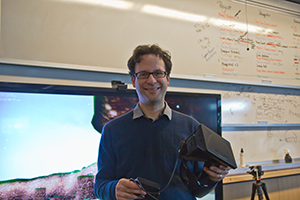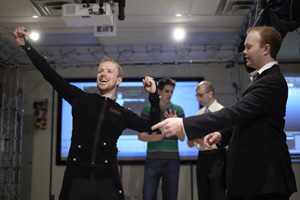UOIT’s partnerships with gaming technology manufacturers open doors for students
March 12, 2014

The world of video gaming is going through some exciting changes, from the development of new consoles to the growth of virtual reality and cloud gaming. The Game Development and Entrepreneurship (GD&E) program offered through the University of Ontario Institute of Technology’s (UOIT) Faculty of Business and Information Technology (FBIT) provides unique opportunities for students to succeed in the midst of these changes.
According to Neil Schneider, Manager, Immersive Technology Services, FBIT, one of the key differentiators for the GD&E program is the partnerships UOIT has established with some of the biggest players in the gaming market. To date, the program has demonstrated strong relationships with blue-chip companies such as Epson, Panasonic, Advanced Micro Devices (AMD) and Electronic Arts. “We don't just get our students' hands dirty with the latest and most innovative technologies,” Schneider said. “We also have direct access to the people and companies that make these products and technologies work. That's invaluable for mind-hungry students looking to cultivate the next great idea.”
The GD&E program also has unique facilities, including a three-wall (soon to be four-wall) Virtual Reality CAVE, stereoscopic 3D displays and monitors, and modern computer labs, with more equipment coming soon – including a 103-inch high-definition TV from Panasonic.
The program’s success can also be attributed to the calibre of its faculty. “You won't find a more tireless and committed faculty anywhere in the world,” he said. “The teachers and mentors have great energy and drive, and they instil this in their students. It's between classes that I see this excitement with professors launching new research, holding game jams with new technologies, or launching events so students can show off their work to industry and peers.”
Finally, the program’s title speaks volumes – not only do students acquire the skills necessary to work for someone else, but the Entrepreneurship part of the program teaches them how to partner with like-minded people and get new businesses off the ground. “I think that’s something the industry really needs right now,” he said. “If students want it, the opportunity is there for them.”
Virtual reality, augmented reality and 3D technologies – some of Schneider’s specializations – have been creating a buzz in the gaming industry. Tom’s Hardware, a technology website, recently published an interview with Schneider in which he described how he became involved in immersive technology and virtual environments. It also talked about immersive technology initiatives at UOIT, profiled students’ work and highlighted UOIT’s Virtual Reality Cave.

“The future of consumer-level games will use hardware that doesn't exist yet in ways that we can only dream of right now,” said Dr. Andrew Hogue, Program Director and Assistant Professor of the GD&E program. “The virtual reality and immersive technology that we are developing allow us to explore new display configurations, new interaction strategies and simulate potential new hardware configurations. This enables students to understand the design constraints necessary to develop amazing content.”
New technologies are redefining how games are made. Immersive products, such as the Oculus Rift virtual-reality headset and castAR 3D glasses, are closing the gap between developers of triple-A games created by major studios and funded by large budgets, and independent game developers. “The potential goes beyond gaming,” Schneider added. “The same skills can and will be used to develop serious games (for professional rather than entertainment purposes), now that these technologies are becoming readily and available and affordable.”
Schneider advises students interested in game development to consider programs that have a pulse on what’s happening in the market, have demonstrated industry relationships, and that are enough ahead of the curve to give students the skills they will need four years from now. “It’s not where students graduate from that will define their careers,” he said. “Instead, it’s the drive, skills and tools they walk away with that will determine their ultimate path. The GD&E program at UOIT fills these needs, and there is more to come.”


